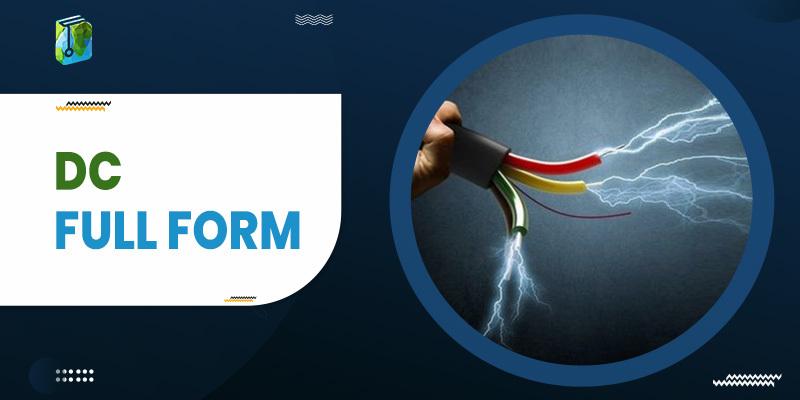DC full form is Direct Current. It is referred to as an electric current in which the flow of charge is unidirectional, i.e., the electrons flow in a single direction. It is used in all household electronic equipment that uses a battery. In contrast, Alternative Current (AC) is the continuous movement of electrons in alternate directions.
DC Full Form
To convert AC to DC rectifier is used, and to convert DC to an AC inverter is used.
Direct Current Electricity is the regular movement of electrons from a negative (−) charged field to a positive (+) charged field through a conductor such as a metal wire.
DC Circuit
A DC circuit allows the flow of the stream of electrons. It consists of a source of electrical energy (such as a battery) and a conducting wire connected from the positive end of the reference to the negative terminal. Electrical devices may be included in the circuit.
Electricity in a DC circuit consists of voltage, current, and resistance. Voltage (measured in terms of Volt) is potential energy, current (measured in terms of Ampere) is the number of electrons flowing through the wire, and resistance (measured in terms of Ohm) is the friction force on the electron flow.
The flow of Direct Electric Current occurs only when the Electric Circuit is closed, but it is topped entirely when the circuit is open.
A Switch is a device used to transmit an Electric Circuit. While the Switch is closed, the circuit is closed, and the electric equipment turns on; while the Switch is opened, the circuit is open, and the electronic equipment turns off.
Common applications of DC
This form of power is most commonly produced by sources such as solar cells, batteries, and thermocouples.
DC power is used in charging batteries, automotive applications, aircraft applications, and other low voltage, low current applications. All solar panels nowadays produce DC power.
Advantages-
- The DC transmission regulates voltage in a better way, reducing its fluctuation. The DC transmission requires less number of conductors compared to that of AC.
- Due to low potential stress on the conductors, less insulation is required.
- Uniform distribution of current over the cross-section of the conductor results in low Skin effect in transmission lines.
Disadvantages-
- DC is not compatible with high voltage transfer as compared to AC.
- The DC transmission over long wire results in the loss of a large amount of power.
DC Full Form: Deputy Commissioner
The full form of DC stands for Deputy Commissioner. They are the head of the district administration at the district level and report directly to the Commissioner.
The duties assigned to a Deputy Commissioner are-
- Maintenance of law & order in the district.
- To ensure coordination with the administrative officers coming under their purview.
- Regulation over the development projects in the districts, laid down by the Government/ implementing agencies, ensures smooth coordination between various departments, including Police and Security Forces.
- Act as the head of several committees like District Rural Development Agency (Under RD), District Mission Authority (under SSA), District Level National Rural Health Mission, District Sports Council, etc.
- Conducting appointments to various posts under their jurisdictions at the Grade-III and Grade-IV levels.
- He is the Chief Revenue Officer as District Collector and is responsible for collecting Revenue and other Govt. dues recoverable as arrears of Land Revenue.
Conclusion
DC full form is Direct Current and Deputy Commissioner. It is referred to as an electric current in which the flow of charge is unidirectional, i.e., the electrons flow in a single direction. Here is everything you need to know about DC in detail.
People are also reading:

